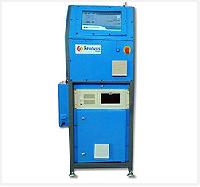
Inspection Automation Systems
Get Price Quote
we are amongst the reckoned names in the industry, offering functionally advanced range of machine vision inspection automation systems that are durable in nature and performance oriented. They are sturdy in construction and are abrasion resistant in nature. technically superior design allows for1] very high rate of inspection upto 600 components2] accuracy of upto 10 micron3] easy user interface( customer specified regional language)4] plug and play (unskilled labor can operate) customized solutions can be provided 1] as standalone system with feeder and sorter2] for missing operation detection and sorting3] to integrate into existing manufacturing line thereby eliminating separate process for inspection.4] to integrate machine vision into existing machine5] refurbish existing machine vision systems for any new adaptations6] cutting tool inspection for machine tools
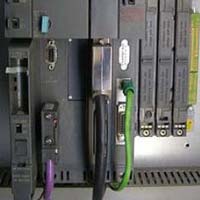
Programmable Logic Controller
Get Price Quote
We are a distinguished Importer and Supplier of Programmable Logic Controller in Karnataka, India. The Programmable Logic Controller or programmable controller is a digital computer, which is used for the automation of typically industrial electromechanical processes, such as control of machinery on factory assembly lines, amusement rides, or light fixtures. PLCs are used in many machines, in many industries. PLCs are designed for multiple arrangements of digital and analogue inputs and outputs, extended temperature ranges, immunity to electrical noise, and resistance to vibration and impact. Programs to control machine operation are typically stored in battery-backed-up or non-volatile memory. A PLC is an example of a "hard" real-time system since output results must be produced in response to input conditions within a limited time, otherwise unintended operation will result. Programmable Logic Controller, PLC, or Programmable Controller is a digital computer used for automation of typically industrial electromechanical processes, such as control of machinery on factory assembly lines, amusement rides, or light fixtures. PLCs are used in many machines, in many industries. PLCs are designed for multiple arrangements of digital and analog inputs and outputs, extended temperature ranges, immunity to electrical noise, and resistance to vibration and impact. Programs to control machine operation are typically stored in battery-backed-up or non-volatile memory. A PLC is an example of a "hard" real-time system since output results must be produced in response to input conditions within a limited time, otherwise unintended operation will result. Programming : Early PLCs, up to the mid-1990s, were programmed using proprietary programming panels or special-purpose programming terminals, which often had dedicated function keys representing the various logical elements of PLC programs.[2] Some proprietary programming terminals displayed the elements of PLC programs as graphic symbols, but plain ASCII character representations of contacts, coils, and wires were common. Programs were stored on cassette tape cartridges. Facilities for printing and documentation were minimal due to lack of memory capacity. The oldest PLCs used non-volatile magnetic core memory. More recently, PLCs are programmed using application software on personal computers, which now represent the logic in graphic form instead of character symbols. The computer is connected to the PLC through Ethernet, RS-232, RS-485, or RS-422 cabling. The programming software allows entry and editing of the ladder-style logic. Generally the software provides functions for debugging and troubleshooting the PLC software, for example, by highlighting portions of the logic to show current status during operation or via simulation. The software will upload and download the PLC program, for backup and restoration purposes. In some models of programmable controller, the program is transferred from a personal computer to the PLC through a programming board which writes the program into a removable chip such as an EPROM Functionality : The functionality of the PLC has evolved over the years to include sequential relay control, motion control, process control, distributed control systems, and networking. The data handling, storage, processing power, and communication capabilities of some modern PLCs are approximately equivalent to desktop computers. PLC-like programming combined with remote I/O hardware, allow a general-purpose desktop computer to overlap some PLCs in certain applications. Desktop computer controllers have not been generally accepted in heavy industry because the desktop computers run on less stable operating systems than do PLCs, and because the desktop computer hardware is typically not designed to the same levels of tolerance to temperature, humidity, vibration, and longevity as the processors used in PLCs. Operating systems such as Windows do not lend themselves to deterministic logic execution, with the result that the controller may not always respond to changes of input status with the consistency in timing expected from PLCs. Desktop logic applications find use in less critical situations, such as laboratory automation and use in small facilities where the application is less demanding and critical, because they are generally much less expensive than PLCs. Features : Control panel with PLC (grey elements in the center). The unit consists of separate elements, from left to right; power supply, controller, relay units for in- and output.The main difference from other computers is that PLCs are armored for severe conditions (such as dust, moisture, heat, cold), and have the facility for extensive input/output (I/O) arrangements. These connect the PLC to sensors and actuators. PLCs read limit switches, analog process variables (such as temperature and pressure), and the positions of complex positioning systems. Some use machine vision.[4] On the actuator side, PLCs operate electric motors, pneumatic or hydraulic cylinders, magnetic relays, solenoids, or analog outputs. The input/output arrangements may be built into a simple PLC, or the PLC may have external I/O modules attached to a computer network that plugs into the PLC. Scan time : A PLC program is generally executed repeatedly as long as the controlled system is running. The status of physical input points is copied to an area of memory accessible to the processor, sometimes called the "I/O Image Table". The program is then run from its first instruction rung down to the last rung. It takes some time for the processor of the PLC to evaluate all the rungs and update the I/O image table with the status of outputs.[5] This scan time may be a few milliseconds for a small program or on a fast processor, but older PLCs running very large programs could take much longer (say, up to 100 ms) to execute the program. If the scan time were too long, the response of the PLC to process conditions would be too slow to be useful. As PLCs became more advanced, methods were developed to change the sequence of ladder execution, and subroutines were implemented.[6] This simplified programming could be used to save scan time for high-speed processes; for example, parts of the program used only for setting up the machine could be segregated from those parts required to operate at higher speed. Special-purpose I/O modules may be used where the scan time of the PLC is too long to allow predictable performance. Precision timing modules, or counter modules for use with shaft encoders, are used where the scan time would be too long to reliably count pulses or detect the sense of rotation of an encoder. The relatively slow PLC can still interpret the counted values to control a machine, but the accumulation of pulses is done by a dedicated module that is unaffected by the speed of the program execution. System Scale : A small PLC will have a fixed number of connections built in for inputs and outputs. Typically, expansions are available if the base model has insufficient I/O. Modular PLCs have a chassis (also called a rack) into which are placed modules with different functions. The processor and selection of I/O modules are customized for the particular application. Several racks can be administered by a single processor, and may have thousands of inputs and outputs. Either a special high speed serial I/O link or comparable communication method is used so that racks can be distributed away from the processor, reducing the wiring costs for large plants. Options are also available to mount I/O points directly to the machine and utilize quick disconnecting cables to sensors and valves, saving time for wiring and replacing components. User Interface : See Also : User interface and List of human-computer interaction topics PLCs may need to interact with people for the purpose of configuration, alarm reporting, or everyday control. A human-machine interface (HMI) is employed for this purpose. HMIs are also referred to as man-machine interfaces (MMIs) and graphical user interfaces (GUIs). A simple system may use buttons and lights to interact with the user. Text displays are available as well as graphical touch screens. More complex systems use programming and monitoring software installed on a computer, with the PLC connected via a communication interface. Communications : PLCs have built-in communications ports, usually 9-pin RS-232, RS-422, rs-485, Ethernet. Various protocols are usually included. Many of these protocols are vendor specific. Most modern PLCs can communicate over a network to some other system, such as a computer running a SCADA (Supervisory Control And Data Acquisition) system or web browser. PLCs used in larger I/O systems may have peer-to-peer (P2P) communication between processors. This allows separate parts of a complex process to have individual control while allowing the subsystems to co-ordinate over the communication link. These communication links are also often used for HMI devices such as keypads or PC-type workstations. Formerly, some manufacturers offered dedicated communication modules as an add-on function where the processor had no network connection built-in. Programming : PLC programs are typically written in a special application on a personal computer, then downloaded by a direct-connection cable or over a network to the PLC. The program is stored in the PLC either in battery-backed-up RAM or some other non-volatile flash memory. Often, a single PLC can be programmed to replace thousands of relays.[7] Under the IEC 61131-3 standard, PLCs can be programmed using standards-based programming languages. A graphical programming notation called Sequential Function Charts is available on certain programmable controllers. Initially most PLCs utilized Ladder Logic Diagram Programming, a model which emulated electromechanical control panel devices (such as the contact and coils of relays) which PLCs replaced. This model remains common today. IEC 61131-3 currently defines five programming languages for programmable control systems: function block diagram (FBD), ladder diagram (LD), structured text (ST; similar to the Pascal programming language), instruction list (IL; similar to assembly language), and sequential function chart (SFC).[8] These techniques emphasize logical organization of operations.[7] While the fundamental concepts of PLC programming are common to all manufacturers, differences in I/O addressing, memory organization, and instruction sets mean that PLC programs are never perfectly interchangeable between different makers. Even within the same product line of a single manufacturer, different models may not be directly compatible. Security : Prior to the discovery of the Stuxnetcomputer worm in June 2010, security of PLCs received little attention. PLCs generally contain a real-time operating system such as OS-9 or VxWorks, and exploits for these systems exist much as they do for desktop computer operating systems such as Microsoft Windows. PLCs can also be attacked by gaining control of a computer they communicate with.[9] Simulation : In order to properly understand the operation of a PLC, it is necessary to spend considerable time programming, testing, and debugging PLC programs. PLC systems are inherently expensive, and down-time is often very costly. In addition, if a PLC is programmed incorrectly it can result in lost productivity and dangerous conditions. PLC simulation software such as PLCLogix can save time in the design of automated control applications and can also increase the level of safety associated with equipment since various "what if" scenarios can be tried and tested before the system is activated.[10] Redundancy : Some special processes need to work permanently with minimum unwanted down time. Therefore, it is necessary to design a system which is fault-tolerant and capable of handling the process with faulty modules. In such cases to increase the system availability in the event of hardware component failure, redundant CPU or I/O modules with the same functionality can be added to hardware configuration for preventing total or partial process shutdown due to hardware failure. PLC compared with other control systems : PLCs are well adapted to a range of automation tasks. These are typically industrial processes in manufacturing where the cost of developing and maintaining the automation system is high relative to the total cost of the automation, and where changes to the system would be expected during its operational life. PLCs contain input and output devices compatible with industrial pilot devices and controls; little electrical design is required, and the design problem centers on expressing the desired sequence of operations. PLC applications are typically highly customized systems, so the cost of a packaged PLC is low compared to the cost of a specific custom-built controller design. On the other hand, in the case of mass-produced goods, customized control systems are economical. This is due to the lower cost of the components, which can be optimally chosen instead of a "generic" solution, and where the non-recurring engineering charges are spread over thousands or millions of units.
Best Deals from Instrumentation Equipment

Agriculture Motor Starter
Get Price Quote

Reliable Static Control Ionization
Get Price Quote
Reliable Static Control & Balanced Ionization for ISO Cleanliness Class 4 Environments Simco-Ion's AirForce Model 6115 Blow-off Gun's power makes the AirForce effective in removing particle contamination and ideal for use in clean process applications. The 6115 is the only gun product rated at ISO 14644-1 Class 4 cleanliness (Fed. Std. 209e Class 10 equivalent). Steady-state DC ion emission provides efficient ionization with an average discharge time of less than 1.0 second. Ergonomic gun design Flexible, lightweight air hose with integral low voltage power cable Replaceable emitter point assembly and quick-eject filter Strong blow-off force Steady-state DC ion emission IsoStat® technology Durable static-dissipative materials ISO 14644-1 Class 4 cleanliness operation

delta plc
5,000 Per Piece
Dvp14ss211r - relay output, we can able to give the technical solutions. We have different range of model in plc for different kind of application
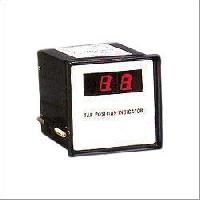
tap position transmitters
Get Price Quote
tap position transmitters, RTCC Panels, Automatic Voltage Regulating Relays
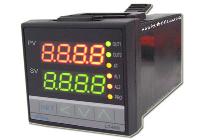
Automatic Street Control System
Get Price Quote
Automatic Street Control System, Automatic Day Night Light Timer

frp auto mobile components
Get Price Quote
frp auto mobile components, fiber reinforced plastics

Electrical Control Panels
Get Price Quote
Electrical Control Panels are an essential component in any industrial environment and residential complex to ensure that adequate control is established over the electrical power distributed within the area. We manufacture sturdy and durable control panels for electrical control that are guaranteed to provide accurate readings even in conditions of high load and voltage fluctuations. To purchase our products, kindly contact our sales executives for further details.
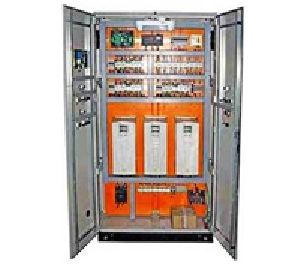
Variable Frequency Drive Panel
Get Price Quote
VFD - Variable frequency drive panel is used to control the rotating speed of AC electric motor by controlling the intensity of electric power provided to the motor. The working of these VFD panels needs to go through speed variations so during their manufacturing they undergo tests on various parameters. The VFD panels are widely used in paper mills, extruder plants, rolling Mills, and cable industry which are effectively used in various industrial applications. We manufacture diverse range of VFD panels which is designed using advanced technology. These are available in various dimensions and standard sizes as per the clients’ specifications. Features of our VFD panels are: Fabricated by taking care of performance and quality standard which makes it efficient and reliable Designed and manufactured as per the relevant standards

Solar Panel
Get Price Quote
We are offering solar panel features……. long lasting variation in model durability we are one of the leading organizations engaged in offering a wide range of solar products, which is durable and is reckoned for optimum performance, robust construction and high efficiency. These are manufactured using quality tested raw material and are offered in varied specifications. Available at industry leading prices, these products are used in different industrial applications our company holds specialization in providing services of solar panel. We offer our services in various industries like electrical industry, automotive industry and many more. We make use of top quality steel for the fabrication process. We keep in mind the needs and requirements of the clients for offering our services. Our services can be availed at highly affordable prices. Http:www.finepunchfab.in20150920solar-panel-manufacturers-in-bangalore-finepunchfabpvt-solar-panel-manufacturersolar-panel-bord-in-bengalurusolar-panel-price-in-bangaloresolar-panel-bord-manufacturers-in-bangalorekarnatakaindiasheet metal fabricators cable tray and junction box manufacturers fine punch fab is sheet metal fabricators in bangalore. We manufactures pedestal storage lockers, cable tray ,tool racks,metal pallets, sheet metal enclosures, dustbin, metal pallets,acrylic laser cutting, lockers, ladders, conveyors, , junction box et cable tray,junction box,lockers,dustbin,pedestal storage lockers,sheet metal fabrication,heavy metal fabrication,metal container, sheet metal enclosure,metal pallets, machine guard,ladder,tool racks,safe lockers,storage racks,acrylic laser cutting,pallet cups

Flame Sensor
Get Price Quote
module features:1, Flame sensor can detect flame or Fire at 760 nm wavelength, or ~ 1100 nm range of the light source, it can detect flame from a distance of 20cm, Greater the flame the detecting distance also increases.2, detection angle 60 degrees, the flame spectrum particularly sensitive.3, adjustable sensitivity (shown in blue digital potentiometer adjustment)4, Driving ability, more than 15mA5, Operating Voltage 3.3V-5V6, Output format: Digital switching output (0 and 1) or Analog Output.7, with fixed bolt hole for easy installation8, Small PCB size: 3.2cm x 1.4cm9, Using a wide LM393 voltage comparator Working:1, The flame sensor most sensitive to ordinary light is also a reaction, generally used as fire alarm and other purposes.2, A small panel output interface can be directly connected with the microcontroller IO port.3, The sensor and the flame should maintain a certain distance, so as not to damage the sensor.

Festoon Cable
320 Per Meter

Auto Components
Get Price Quote
Primary focus is on highly engineered moulds for automotive application . Close tolerance components for wire harness connectors, electro mechanical sensors are being molded at high volumes

Motor Starter
Get Price Quote
The motor starter shall be automatic starDelta type conforming to IS 1822-1967. The unit shall include suitable current transformer and ammeter of suitable range on one line to indicate the current.

Transformers
Get Price Quote
Transformers, Ups System, servo automatic voltage stabilizer

Metering Cubicle
Get Price Quote
Metering Cubicle, l t panel boards, HT Panels boards, Busbar trunking system

Transformers
Get Price Quote
Transformers, Electric Motors, Voltage Stabilizers

Amf Panel
Get Price Quote
Amf Panel, Electrical Panel Boards, switch boards, mcc, Bus Ducts
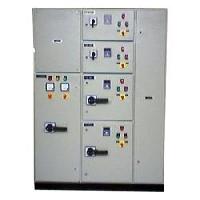
Electric Panel Board
Get Price Quote
Electric Panel Board

Occupancy Sensor
Get Price Quote
Occupancy Sensor, Intrusion Alarm System, Fire Alarm System

Control Relay Panels
Get Price Quote
We are well known for manufacturing, supplying and exporting of wide variety of Control Relay Panels in India.

Precision Auto Turned Components
Get Price Quote
Precision Auto Turned Components, Drilling, tapping

automobile precision pressed components
Get Price Quote
automobile precision pressed components

Precision Auto Turned Components
Get Price Quote
Precision Auto Turned Components, precision auto turned parts

JUMPER ASSEMBLY
Get Price Quote
JUMPER ASSEMBLY, POI and CONNECTORS, Repeater, Antennas, cavity splitter

Micro controller Based Tap Position Transmitter
Get Price Quote
Micro controller Based Tap Position Transmitter

assembly automation equipment
Get Price Quote
assembly automation equipment, medical implants, Industries Machine

Precision Auto Turned Components
Get Price Quote
Precision Auto Turned Components, precision auto turned parts

Aluminium Bus Bar
Get Price Quote
Aluminium Bus Bar, Die Casting, Aluminium